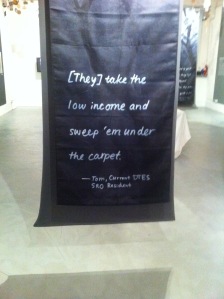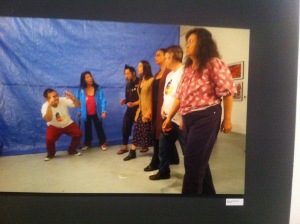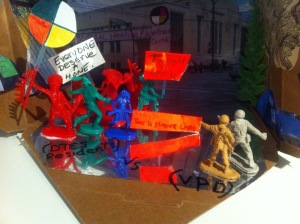Gallery Gachet
http://gachet.org/exhibitions/the-right-to-remain/
We arrived, with Russell’s blessing to “just knock on their door and see if they’ll let you in.” The Show wasn’t opening until later that evening, but we had to be back to friends/or the ferry by than. They did let us in and they were so happy too, they even let us take photos. We were very clear to ask if they were really okay with it, and that it was okay if they were not. After we asked if we could take some posters to put up at UVic, they were really grateful, and we were really happy to contribute in a small way to their exhibition.
Gallery Gachet’s exhibit was ‘Right to Remain, Right to Remain: A Creative Repossession of the Human Rights Legacies of Vancouver’s Downtown Eastside,’The “Right to Remain” project is the second phase of the “Revitalizing Japantown?” research project in partnership with Queen’s University and the Nikkei National Museum and Cultural Centre. This is a collaborative project between residents of the DTES. Japanese Canadian, other community organizations, and Indigenous Canadians living in the East Hastings area all participating in the questions surrounding the gentrification, citizenship, history, poverty of East Hastings. Also about how revitalizing the area under the name “Japantown” is somewhat problematic and a step towards the challenges that Chinatown is having: gentrification, the erasure of histories and voices. Here we saw the indigenous people and Asian Canadians working together as marginalized members of a community being erased, ignored, and spatially segregated.
“Our Purpose: One of the many assets of the DTES are the numerous, strong and vocal community organizations working to keep the priorities of the residents at the forefront of consultations in light of social and political attempts of gentrification. However, the complex, overlapping and layered histories of the area mean that these voices are often fragmented and with this, their capacity strained. The purpose of this project is to develop a coalescing partnership with DTES community organizations to put forward a collective and sustained human rights agenda for the DTES. Our aim is to do this through historical reclamation to lineage past and present actions for, and violations against, human rights, community dialogues on priorities for a unified human rights agenda, and arts-centered approaches with local artists to project and support what we have learned to the larger community.”www.revitalizingjapantown.ca
Art as resistance and community participation
It used many different mediums, for example: dioramas, photography, comic strips (drawn by DTES residents), Tableau’s, and quotations to allow many voices to be heard. They also had opportunities for viewer contribution through writing on postcards and interactive guest books. The art and dioramas were created through community workshops that enabled residents to participate and express their view and stories. This collaborative approach was what Tyler Russell was talking about earlier, and exhibit had all kinds of examples of ways residents could tell their stories and participate.
(Alicia) I loved seeing the Tableaus, and comic strips, and little dioramas. There was so much to see, it was very emotional and profound. To read stories about people’s lives, and see the way these artists and researchers created an exhibit to give voice to the residents of a community that have had their basic human rights violated (access to shelter, food, water, etc.). It was very emotional, and I really felt like it represented how art was the most powerful medium in this visual culture.
Above are some of the dioramas, and tableaus in the exhibit, below are screenshots from their website of the workshop in which they were created the art. They speak to the feelings of residents being silenced, ignored, put on display (turned into part of the exhibit of the DTES, notice the person taking the photo in the bottom tableau).
http://www.revitalizingjapantown.ca/
The use of the space was quite interesting too, the gallery was a yoga studio, somewhere they held community talks, and art workshops, etc. (see brochure below).
Also, the complicated history of racial/spatial segregation of marginalized groups was really striking. This project drew special attention not only to the current situations in the E.Hastings area and Cordova st., but also to Powell St. and the “Japantown” revitalization (which encompases Cordova st. as well ). I didn’t know about the history of Powell st., that it was once Japantown until the WW2 evictions of the Japanese residents. Below are some of the websites we looked at to learn about the history and current issues facing this new threat of gentrification and a whole new erasure of histories.
http://www.vancouverheritagefoundation.org/wp-content/uploads/2013/01/MGJapantown_web.pdf
http://www.vancouversun.com/Japantown+Vancouver+lost+neighbourhood+with+video/9483788/story.html






